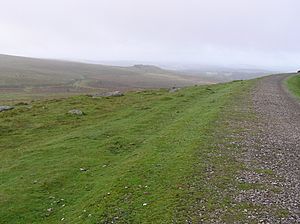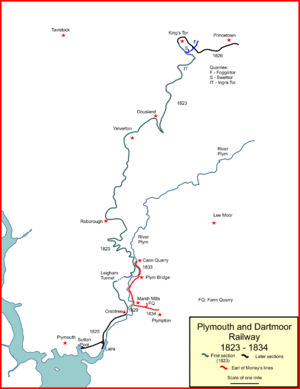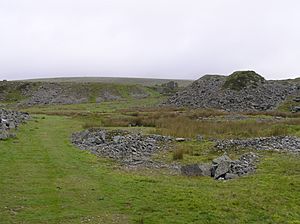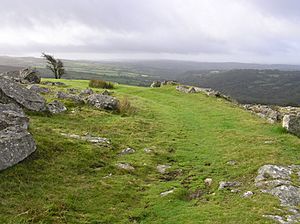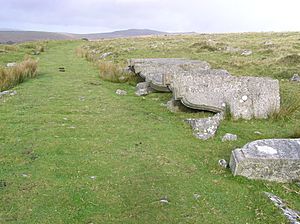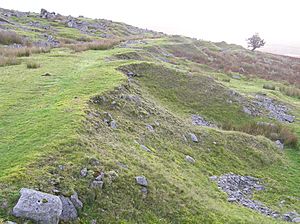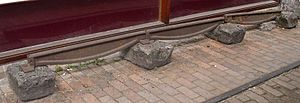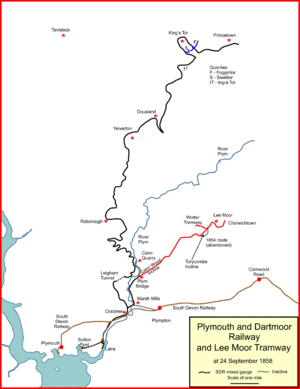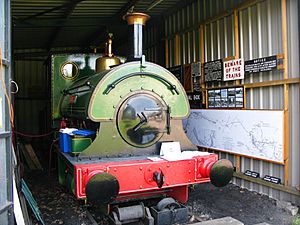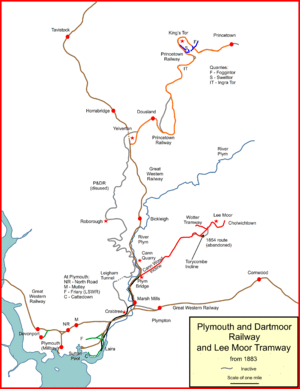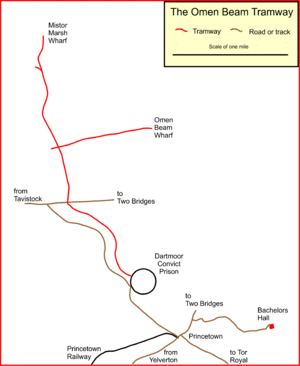Plymouth and Dartmoor Railway facts for kids
The Plymouth and Dartmoor Railway (P&DR) was a railway built in Devon, England, to help the economy of the moorland areas around Princetown. It used a special track width of 4 feet 6 inches. People who owned wagons could use the railway by paying a fee, and horses pulled their wagons. The P&DR opened in 1823, and more short railway lines were added over the next few years.
The Lee Moor Tramway (LMT) started as a branch of the P&DR in 1856. By then, digging for china clay had become a big business. The LMT carried this clay down to places where it could be processed and then shipped from Plymouth. The LMT also used horses, but it also had steam engines and special slopes where wagons were pulled by ropes.
The Omen Beam Tramway was a separate railway used to collect peat (a type of soil made from decayed plants) from the moor above Dartmoor prison. This peat was used to make naphtha, a chemical.
The P&DR cost much more money than expected. The plan to improve farming on the moor didn't really happen. Instead, the railway was mostly used by a trading company that transported granite to Plymouth for shipping. Later, china clay was found on Lee Moor, and a branch of the P&DR was built to bring it to Plymouth. The original P&DR line was used less and less. Its upper part was later used for the Princetown Railway. However, the LMT branch and a small part of the lower P&DR line continued to be used until 1960. The railway famously crossed the main Exeter to Plymouth train line, and many old photos show horse-drawn wagons crossing the busy main railway tracks.
Contents
How the Railway Started
The First Ideas
Sir Thomas Tyrwhitt was a wealthy and kind landowner in Devon and Cornwall. He had created a settlement called Princetown on Dartmoor and wanted to make life better for the people living there. Dartmoor prison was finished in Princetown in 1809 to hold prisoners of war, but after 1815, the prison became empty.
Tyrwhitt wanted to improve farming and mining on Dartmoor. He thought a railway connecting Princetown and Plymouth would be a great idea. This railway would bring important materials like lime and sea-sand up to the moor to improve the land, along with wood and coal. It would carry granite, peat, minerals, and farm products down to Plymouth. Wagons would be pulled by horses, and anyone could use the railway by paying a fee, just like a toll road.
Quick facts for kids Plymouth and Dartmoor Railway Act 1819 |
|
|---|---|
| Act of Parliament | |

|
|
| Long title | An Act for making and maintaining a Railway or Tramroad from Crabtree, in the Parish of Egg Buckland, in the County of Devon, to communicate with the Prison of War on the Forest of Dartmoor, in the Parish of Lydford, in the said County. |
| Citation | 59 Geo. 3. c. cxv |
| Dates | |
| Royal assent | 2 July 1819 |
| Other legislation | |
| Repealed by | Plymouth and Dartmoor Railway Act 1865 |
|
Status: Repealed
|
|
| Text of statute as originally enacted | |
In 1818, Tyrwhitt suggested his plan to the Plymouth Chamber of Commerce, promising a good return on investment. People invested money, and a schoolmaster and surveyor named William Shillabear surveyed the route. William Stuart, an engineer working on the Plymouth Breakwater, estimated the construction costs. A bill was sent to Parliament to create the Plymouth and Dartmoor Railway, with Stuart as its engineer. The railway company was officially formed by the Plymouth and Dartmoor Railway Act 1819 on July 2, 1819. It had £27,783 to build the line from Crabtree to Princetown.
Tyrwhitt held a ceremony on August 12, 1819, to lay the first rail. However, the actual building contracts hadn't been given out yet, and the railway's engineering plans still needed some changes.
Extending to Sutton Pool
| Plymouth and Dartmoor Railway (Crabtree and Sutton Pool Branch) Act 1820 | |
|---|---|
| Act of Parliament | |

|
|
| Long title | An Act for making a Branch Railway or Tram Road from a Place called Crabtree, in the Parish of Egg Buckland, to certain Lime Works at a Place called Catdown, and from thence to Sutton Pool, in the Parish of Charles, all in the County of Devon, to communicate with the Plymouth and Dartmoor Railway, at Crabtree aforesaid. |
| Citation | 1 Geo. 4. c. liv |
| Dates | |
| Royal assent | 8 July 1820 |
| Other legislation | |
| Repealed by | Plymouth and Dartmoor Railway Act 1865 |
|
Status: Repealed
|
|
| Text of statute as originally enacted | |
The railway was supposed to go from Crabtree to Princetown. Crabtree was chosen because it was near tidal water on the River Plym. However, this dock could only be used at high tide, and getting there by river was long and difficult. So, the company decided to extend the railway further west to reach Sutton Pool. This required another law, the Plymouth and Dartmoor Railway (Crabtree and Sutton Pool Branch) Act 1820, passed on August 8, 1820. This law allowed the extension and a branch to the Cattewater, adding £7,200 to the cost. William Stuart was put in charge of building it.
In April 1820, contracts were given to William Bailey to supply cast iron rails. These rails were shaped like a fish's belly, about 2 feet 10 inches long and 6 inches deep. They were joined end-to-end on stone blocks. The track width was set at 4 feet 6 inches, but it's not clear why this specific width was chosen.
A contract for building the railway's path was given to Hugh McIntosh in June 1820. It was to be a single track with passing places, called "turnouts," about two per mile. Some of these passing places, like those at Roborough and Yelverton, were made of specially shaped granite blocks to guide the wagon wheels.
On September 21, 1820, the railway company made an important agreement with Johnson and Bryse. This company had rights to dig granite from Dartmoor and needed to transport it to Plymouth for projects like the breakwater and for shipping. They agreed to pay a fixed rate of 2 shillings 6 pence per ton, no matter the distance, for about 8,000 tons per year. This meant a steady income of £1,000 a year for the railway company.
Changing the Main Route
| Plymouth and Dartmoor Railway Act 1821 | |
|---|---|
| Act of Parliament | |

|
|
| Long title | An Act to authorize the Plymouth and Dartmoor Railway Company to vary the Line of a certain Part of the said Railway; and to amend the Acts passed for making the said Railway. |
| Citation | 1 & 2 Geo. 4. c. cxxv |
| Dates | |
| Royal assent | 2 July 1821 |
| Other legislation | |
| Repealed by | Plymouth and Dartmoor Railway Act 1865 |
|
Status: Repealed
|
|
On December 26, 1820, engineer Stuart reported that Shillabear's original route to Jump (later called Roborough) was too steep for horses. He suggested a new route that would make the slope less steep. This was bad news because they had just gotten the second law passed and had already started building some parts of the railway. Stuart was blamed and fired in October 1821. Roger Hopkins was brought in as the new engineer. A new route with easier slopes was approved. It went east of the old route but needed a tunnel called Leigham Tunnel, adding another £5,000 to the cost. A new law, the Plymouth and Dartmoor Railway Act 1821, was passed on July 2, 1821, to allow this change. The total estimated cost was now £40,000, and the line would be about 25.5 miles long.
The new route had to cross land owned by the Earl of Morley. He had a quarry nearby and demanded that the railway build a connection to it. This was agreed to, but it caused problems later. The contractor McIntosh was also fired in June 1822 because of poor building quality. Johnson Brothers took over the work. Hopkins, now the main engineer, changed the design for later rails. They were to be 3 feet 10 inches long with overlapping joints at the stone blocks.
Opening and New Lines
The Grand Opening
Building the railway was very difficult financially. The company barely kept going with loans. So, there was great relief when the line finally opened on September 26, 1823, with a celebration breakfast. The first part of the line opened between Crabtree and the bottom of Kings Tor, Walkhampton.
The railway twisted and turned a lot to keep a gentle downhill slope towards Plymouth. In a straight line, the distance was about 13 miles. The track was 4 feet 6 inches wide, and the rails were bolted to cast iron holders on stone blocks. The Leigham tunnel was 620 yards long, and there was one stone bridge near Plym Bridge over the road from Roborough to Plympton.
John and William Johnson, who ran the quarries at Walkhampton, soon found that their granite traffic brought in most of the railway's money. The railway didn't get much business from farming or other goods as hoped. Also, the company had spent all its money and couldn't repay its loans. Because of this, the Johnson Brothers built the extensions to Sutton Pool and Princetown themselves. In return, they got a mortgage on the company and could use their railway fees to pay off what was owed to them. This way, the line was completed all the way to Princetown in 1826. The end of the line in Princetown was a few hundred yards east of where the later Great Western Railway station would be.
The Earl of Morley had given land for the railway on the condition that a branch line be built to his quarry in Cann Wood. He pushed the company to do this. However, he actually turned an existing water channel (a leat) into a canal, the Cann Quarry Canal, from his quarry to near Marsh Mills. The Plymouth and Dartmoor Railway then built a half-mile branch from near Crabtree to a basin on this canal. These opened around late 1829 or early 1830. This meant goods had to be moved from the canal to the railway, and operating boats on the fast-flowing canal was hard. So, the branch was extended northwards to Plymbridge in 1833, mostly along the canal's towpath.
Morley also had interests in digging china clay (a type of kaolinite) at Lee Moor, a bit northeast of Marsh Mills. He arranged with Johnson Brothers for them to extend the P&DR east from Marsh Mills to Plympton. From Plympton, the china clay could be brought down from Lee Moor by packhorse. This extension opened in 1834. It's not clear if this railway extension belonged to Morley or the Johnsons, but it's generally considered part of the P&DR.
Passenger Journeys
The P&DR was not planned or allowed to carry passengers. However, there is a story from a diary by William Bray, a rector from Tavistock. He wrote about seeing a "vehicle not much unlike a rude kind of vis-a-vis with an awning" near King's Tor. He thought it might be for "pleasure parties" from Plymouth. It's more likely that this was just a stone wagon with boards for seats, used by the engineer to inspect the railway work.
After the Opening
The railway was supposed to cost £27,783 and make an 18% profit. But by the time it opened, £37,000 had been invested, and £28,000 had been borrowed from the government. The Johnson Brothers had a very good deal for their granite transport, and any money from it would go back to them to pay off their loans. There wasn't much other general traffic. The Johnson Brothers' dominance is clear from the money earned between September 1823 and July 1825:
- Johnson Brothers: £1093
- Everyone else: £29.
Now, the Earl of Morley demanded that the railway connect to his Cann Wood Quarry, as promised in 1821. With the government also demanding loan repayments, the company was in serious trouble.
Despite the problems, the Sutton Harbour extension was finished in December 1825, and the final section to Princetown in December 1826. The end of the line in Princetown was behind the building that later became the Railway Inn.
In desperation, the company agreed to lower the fees for the Johnson Brothers. In return, the Johnsons' special deal would end seven years later. Lord Morley, seeing the situation, built a canal from his quarry to Marsh Mills in exchange for low rates. This canal was just a wider version of an existing water channel and didn't work very well. However, a branch from the P&DR to Marsh Mills, crossing the River Plym, opened around late 1829 or early 1830.
Lord Morley also had interests in china clay (kaolinite) at Lee Moor. In 1833, he agreed with the Johnson Brothers that they would build a branch line to Plympton, mostly along the northern edge of the Exeter Turnpike road. China clay would be brought from Lee Moor to Plympton by packhorse. This line was finished by mid-1834 and leased to the Johnson Brothers for 75 years.
The seven-year agreement with the Johnson Brothers gave them control over granite transport until 1834. But when it ended, no other company came forward to challenge their strong position.
Sir Thomas Tyrwhitt died in 1833. His dream of developing farming on the moor had failed. As early as 1825–26, visitors from Germany noted that the railway had missed its main goal and could barely pay its costs because it only transported granite.
The huge amount of money spent over the original budget was partly covered by government loans of £28,000. The government kept asking for repayment, which the company couldn't afford. The railway was basically the private property of the Johnson Brothers, and they likely made some payments to prevent the government from taking it over.
The Johnson Brothers' business grew over the years. In 1846, Rachel Evans wrote about the quarries: "An immense excavation presents itself studded with workmen... horses, carts and railway waggons, are in constant employment, to convey away the heavy masses of stone... the Post Office and London Bridge, were constructed of this strong material, and at present it is furnished for building the new houses of parliament..."
How the Railway Looked
The Main Line
The P&DR was a railway where horses pulled wagons. It used short cast iron rails on stone blocks, with a track width of 4 feet 6 inches. It was built to improve the moorland areas around Princetown, but granite quarries ended up providing most of the traffic. The main line went downhill from Princetown to Crabtree, east of Laira. It took a very winding path to keep the uphill slope gentle. In some places, the curves were extremely tight to avoid major digging work.
A writer named Priestley described the line in 1831: "Starting at Bachelor's Hall near Dartmoor prison, the Plymouth and Dartmoor Railway takes a very winding path from north to south... to Crabtree... where the original line ended; from there, it continued... to Sutton Pool, a short distance south of Plymouth."
From Princetown, the line went west, passing between Foggintor Quarry and Swelltor Quarries. It curved around King's Tor and Ingra Tor, then headed south past Peekhill and across Yennadon Down. South of Dousland, it made a sharp turn north again to stay on the same level, passing west of Yelverton. Near the Roborough road, the line went south, curving past Clearbrook, and then twisted many times as it went down west of the Tavistock Road through wooded areas. Finally, it turned west through Leigham Tunnel and continued twisting down west of the River Plym to reach a spot west of Marsh Mills. Here, it turned west again and followed the north bank of the Plym to reach Crabtree wharf.
On some similar railways, horses would ride on a special vehicle during the downhill journey, but there's no sign this happened on the P&DR. The line had a single track with many passing places so that wagons going in opposite directions could pass each other.
The railway was meant to be a toll line, meaning any carrier could use it for their wagons. However, the Johnson Brothers' quarry traffic was so dominant that the main line became almost like their private railway.
The land along the line was mostly moorland and farmland, with few large towns. There were sidings (short tracks for parking wagons) at Yelverton and Roborough, likely for general goods. Closer to Plymouth, the line went to a wharf at Crabtree, and the later extension reached both Sutton Harbour and a wharf on the River Plym at Laira. At the time, these areas were not built up with city buildings.
Branch Lines
The extension to Marsh Mills was built in a similar way but on flatter ground. The further extension to Plympton ran along the northern edge of the Exeter turnpike road. There was a two-span cast iron bridge at Marsh Mills. When the line was extended to Cann Quarry, it was laid on the towpath of the old canal.
Where the P&DR crossed the South Devon Railway main line, wooden boards were laid between the P&DR rails for the horses to walk on.
The Tracks
The track width was 4 feet 6 inches. The rails were made of cast iron, shaped like a fish's belly, and were 3 to 4 feet long. Unlike later railways, each rail only spanned one gap between stone sleeper blocks and was held in place by cast iron chairs. The later rails (after engineer Hopkins redesigned them) were 46.5 inches long with a 2.5-inch overlap. The top of the rail was 1.75 inches wide, the web (the middle part) was 0.75 inches thick, and the rail was 4 inches deep at the sleeper block and 6 inches deep in the middle. In some places, wooden sleepers were used, measuring 5 feet long by 6 inches wide by 3 inches thick. The earlier rails were joined end-to-end and were 36 inches long with a head width of only 0.5 inches.
It was noted that "These rails do not appear to be fastened so securely and durably as those with overlapping end laps."
Wagons and How They Worked
The main line generally sloped downhill, and it was steep enough to need good brakes. The wagons had two main beams, 9 feet long, with a bed made of 2.5-inch planks reinforced with iron strips. The wheels were cast iron, 29 inches in diameter with 4.5-inch wide treads. The wheel treads were cone-shaped, so the diameter near the flange (the part that keeps the wheel on the track) was 29.75 inches. The axles were 41.5 inches apart. The brakes were made of cast iron and attached to a long wooden lever, acting on both wheels on the same side. The wagons were connected by links 15 inches long.
There was also a mobile crane, mounted on a wagon, that could lift loads of 80 hundredweight (4 tons). This was in addition to the fixed cranes.
South Devon Railway
Crossing at Laira Green
For many years, the P&DR was the only important railway in the area. But in 1843, the South Devon Railway (SDR) planned its line from Exeter to Plymouth. When their bill was presented to Parliament in 1844, it stated that "Messrs John and William Johnson are in possession of and claim to be entitled as mortgagees or assignees to the said Plymouth and Dartmoor Railway..." This was the real situation, and the P&DR owners couldn't get this part of the law removed. The section of the P&DR from Plympton to the junction near Marsh Mills was sold to the SDR and closed in 1847. This allowed the SDR to build its main line without having to cross the P&DR. Lord Morley seemed to agree to this. His china clay traffic from Lee Moor used Plympton as a railway loading point, and he might have thought the SDR would be a better way to get his clay to Plymouth.
The SDR got permission in 1846 to take over the P&DR line between Crabtree and Sutton Pool, but the terms had to be negotiated, which was difficult and slow. At one point, the SDR tried to build a crossing over the P&DR without an agreement:
"The progress of this extension was stopped by a dispute between the South Devon Railway Company and the mortgagee in possession of the Dartmoor Railway... The mortgagee not getting the terms he asked from the South Devon Railway, brought immense blocks of granite from his Dartmoor quarries, and deposited them on the line where the South Devon wished to cross. This effectually prevented the railway from proceeding with the line and they soon arranged a compromise, which had the desired effect, the granite blocks being then removed by the mortgagee of the Dartmoor Railway."
This crossing became known as "the well-known oblique crossing at Laira," though the exact spot was Laira Green.
The South Devon Railway opened its line to Laira Green on May 5, 1848. The station was just on the Exeter side of the Laira crossing. The line was completed to Millbay on April 2, 1849.
Sutton Pool Line Sold
The South Devon Railway wanted to reach Sutton Pool by rail. On April 23, 1851, they finalized an agreement with the Johnson Brothers. Ownership was transferred to the SDR. The SDR would lay mixed gauge track (both their broad gauge and the P&DR's 4 feet 6 inch gauge) to allow the P&DR to still reach Sutton Pool while giving the SDR access from Laira. The Cattewater section (a short track to a wharf on the Plym) was not included. The junction between the Sutton Pool line and the Cattewater line had very tight curves, but this area and the wharves at Laira were operated by horses for the first few years. Some improvements were made to the curve, and the broad gauge tracks opened in May 1853. The SDR got a law, the South Devon Railway (Sutton Harbour Branch) Act 1854, on July 3, 1854, allowing them to strengthen the line for locomotive use and make a change near the Granite Works to ease the curve.
Tavistock Line
When the South Devon Railway reached Plymouth, people were already suggesting a branch line to Tavistock. The South Devon and Tavistock Railway (SD&TR) took the lead. On July 5, 1852, the company made an agreement with Lord Morley, who owned the china clay mines on Lee Moor. The SD&TR agreed to build a branch line to Lee Moor for Morley. In doing so, they would get the right to take over the P&DR's Cann Quarry branch from Marsh Mills, which they needed for their line. The Lee Moor line was supposed to be built right away.
Work began on the Lee Moor branch in September 1852. It was meant to be a key part of the SD&TR lines. Trial operations on the Lee Moor line started in August 1854 but were stopped after an accident on October 4, 1854. An investigation showed that the line was built very poorly.
William Phillips (of J & W Phillips) leased Morley's china clay mines and was counting on the line being finished to get the clay to Plymouth. After his own investigation, it was clear the work was bad. So, in an agreement on June 5, 1856, the SD&TR gave up its interest in the line, and Phillips took over.
The SD&TR opened its line to Tavistock on June 21, 1859, but without taking over any of the P&DR line.
Sutton Pool Improvements
The SDR closed the Laira to Sutton Pool line in 1856 so it could be rebuilt for steam locomotives, as allowed by the 1854 law. When it reopened in 1857, the 4 feet 6 inch gauge and broad gauge lines had been separated between Laira, Prince Rock, and Cattewater. In 1869, the SDR's duty to maintain the 4 feet 6 inch gauge access to Sutton Pool ended. On April 19, they started using locomotives, having removed the Dartmoor gauge rails.
Lee Moor Tramway: Building It
The heavy china clay that William Phillips, Lord Morley's lessee, was digging was located on Lee Moor at an altitude of 900 feet. After the SD&TR failed to build a branch line to Lee Moor, Phillips took over the line on December 20, 1855. He was determined to build the line himself. This became the Lee Moor Tramway, running from Lee Moor to join the P&DR line near Plym Bridge (on the Cann Quarry branch, not the P&DR main line). This was about 2.6 miles long, including a short line to Wotter village. His line was built to the same track width as the P&DR. There was a lot of work to do, including a completely new path at the Torycombe incline and rebuilding several bridges. Phillips finally opened the line on September 24, 1858.
There were two inclines, called Cann Wood and Torycombe. They worked by balancing loaded wagons going down with empty wagons going up. Each incline had a passing loop in the middle. Above the loop, there were three rails, with the middle rail shared. Below the loop, there was a single track. When wagons crossed at the loop, the descending wagons pushed through the points at the lower end of the loop, setting them correctly for the next ascending wagons.
Cann Wood incline was 6600 feet long with a slope of 1 in 11. Torycombe was 2145 feet long with a slope of 1 in 7.
The line went through Lee Moor village to Cholwichtown, and a short line went to Wotter Village (the Wotter Tramway). The original path and incline approaching Lee Moor were closed, but part of it was used as a dead-end track to kilns.
The P&DR from 1865 Onwards
| Plymouth and Dartmoor Railway Act 1865 | |
|---|---|
| Act of Parliament | |

|
|
| Long title | An Act to repeal the Acts relating to the Plymouth and Dartmoor Railway Company; to authorize the raising of additional Capital, and Arrangements with the South Devon Railway Company; and for other Purposes. |
| Citation | 28 & 29 Vict. c. cxxxi |
| Dates | |
| Royal assent | 19 June 1865 |
| Text of statute as originally enacted | |
An agreement was made on May 3, 1865, to restart the Plymouth and Dartmoor Railway Company. All the special shares were owned by William Johnson. This was confirmed by the Plymouth and Dartmoor Railway Act 1865. The new company was profitable enough to pay a small dividend (0.25%) in 1870.
New rails were laid on the P&DR main line: 600 tons of new rail were put down in 1873–74.
Princetown Railway
However, in November 1877, plans were made for the Princetown Railway. This would be a standard gauge branch line from a junction on the Tavistock line at Yelverton. Near Princetown, it would serve the town and the quarries on the P&DR line, which it was meant to replace. Some small changes were made to the P&DR line to allow steam locomotives to run on it. A major new section of track was built to go east of Yennadon Down and descend to the Tavistock line at Yelverton.
The change happened in 1878. The Princetown Railway paid £22,000 in shares for the necessary part of the line, and it opened on August 11, 1883. The Plymouth and Dartmoor Railway's activities were now limited to the Lee Moor traffic from where that line joined. In Plymouth, there were connections with the Great Western Railway (GWR) at Laira and a wharf on the Plym, also at Laira.
Turnchapel Branch
In the 1870s, the GWR and the LSWR (London and South Western Railway) were competing for control of railway areas around Plymouth. The Plymouth and Dartmoor Railway worked with the LSWR to promote local branch lines. They got permission in the Plymouth and Dartmoor Railway (Plymouth Extensions) Act 1875 to build short branches from the P&DR line at Cattewater. The LSWR took over these permissions in 1882, and the branches were connected to the LSWR Friary line.
On August 2, 1883, the P&DR got permission in the Plymouth and Dartmoor Railway Act 1883 to build a line to Turnchapel. It successfully built a bridge over the Plym near Laira road bridge, and the line opened as far as Plymstock (then called Pomphlett) in 1887. The LSWR took over the permissions for this branch, and they opened it on January 1, 1897.
Final Years of the P&DR
By the late 1800s, the P&DR had lost the quarry traffic from Dartmoor (to the Princetown Railway) and almost all its general goods traffic. The Lee Moor line, however, did well as the china clay business grew. So, the china clay transport became the main focus of the remaining company. In 1916, the rails on the unused section above Cann Wood were taken up for scrap metal. Under the Railways Act 1921, the company was transferred to the new Southern Railway. In reality, this only applied to the short branches around the Cattewater. The Lee Moor Tramway continued to be used, running over the southern end of the P&DR main line. The entire route from Lee Moor to Laira became commonly known as the Lee Moor Tramway.
Lee Moor Tramway in Action
In 1862, after all the hard work of building the Lee Moor line, Phillips sold his china clay business and the lease of the line to Mrs. R. Martin.
The main traffic was china clay going downhill to the Cattewater or Laira exchange sidings, and supplies and coal going uphill to Lee Moor. The inclines worked by balancing loaded wagons going down with empty wagons going up. At Cann incline, five loaded wagons going downhill could pull three empty wagons and two loaded wagons up. At Torycombe, water tank wagons were kept ready for when an unbalanced uphill movement was needed.
As traffic increased, steam locomotives were bought in 1899. They worked the section between the inclines, while horses continued to pull wagons above and below them. Heavier rails were installed to prepare for locomotive use.
At Lee Moor, there had been short branches to Wotter and Cholwich Town, but these closed in 1900 and 1910, respectively.
In 1919, the china clay operation and the tramway were sold to English China Clays Limited (ECC). This company later became part of English Clays, Lovering Pochin Ltd (ECLP). From 1936, the section above Torycombe incline was no longer used. The operating company increasingly installed pipelines to transport the china clay as a liquid mixture (slurry) and also used roads.
The last time the tramway was used for commercial purposes seems to have been at the end of 1945. A major pipeline from Lee Moor to Marsh Mills was completed in 1947, making the railway's closure permanent. However, the owning company didn't want to give up the right to use the path. So, small movements carrying sand from Marsh Mills to Maddock's concrete works were made every three months. This continued until the very last movement on August 26, 1960. That was the last time the Lee Moor Tramway horses pulled wagons across the Great Western Railway main line. The tracks on the main line were removed in October and November of that year.
Omen Beam Tramway
In 1844, two businessmen from Plymouth, Jacob Hall-Drew and Peter Adams, tried to start a business processing peat to make naphtha. They rented Tyrwhitt's mill at Bachelor's Hall, east of Princetown. In 1846, they moved to Dartmoor Prison, which was empty at the time. They formed the British Patent Naphtha Company and built a tramroad to Yearlick Ball, north of the prison. This tramroad brought peat from there to a factory at the prison building. They also built a branch line to Omen Beam near Fice's Well. The track width was probably 4 feet 6 inches, and horses pulled the wagons.
The peat was processed to create naphtha, which was used for making candles and mothballs. The fibrous material from the peat was used to make paper. More than 30 tons of peat were used every day.
The rails were nailed directly to wooden sleepers, not stone blocks. Fine gravel was laid between the rails for the horses to walk on. The total cost, probably including the factory, was £19,000. The total length of the tramway was about 2.75 miles.
When the prison reopened for convicts, the entire building was first lit using naphtha gas. In the 1900s, a gas engine ran on this fuel.
The track can easily be seen from the Two Bridges Road east of Rundlestone Corner.
See also
- Railways in Plymouth


